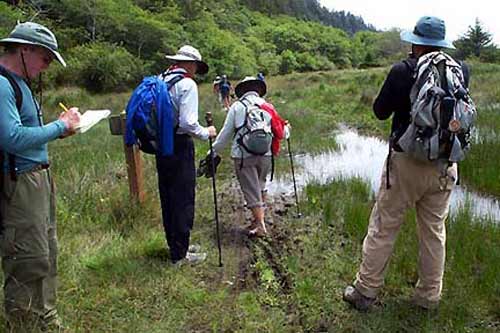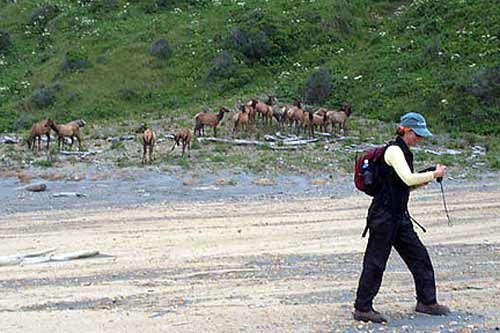

June 7: Humboldt – Leaving Del Norte on the Way South
Before getting up, it sounds like rain on the tent but it is only heavy dew from the fog being shaken from the trees by the first winds of morning. While most of us worked on striking camp, J Nichols barbequed a salmon and cooked scrambled eggs for the whole crew.
Our sprained ankle from yesterday is no better, so Mel will take Helene Baouendi to visit a doctor. So that the group will not be broken up, J takes Helene’s alder wood nametag off of her pack and ties it to his own; in spirit she will be with us.
We begin where we left off, at the mouth of the Klamath.Still there is the young couple who met us there the day before. Their response to an inquiry about their still being there was “Just because you haven’t moved doesn’t mean you haven’t made any progress”. Sound advice from a young person to his elders.
The walk proceeds along Coastal Drive – we are going along the bluff tops with the sea shrouded in the fog below. Along the way we pass “The Farm That Wasn’t”, a World War II radar installation camouflaged as a farmstead and now restored to its 1940s appearance. At a spot where the road passes through an alder grove, wild grouse are flushed out by our presence.
At the Carruthers Cove Trailhead, we meet our guide for the rest of the day, Sue Davis, a long-time Coastwalk volunteer. We drop off the road here and down onto the beach, and stop at the first major rock for our lunch break. Here we see our first elk grazing on the hillside above the beach. Shortly after lunch and just after we walk through a defile in the beach rocks, we come across a herd of 15 or so elk, all cows, young bulls and one new calf. They are bunched together on an alluvial area just off the beach and very close to us. The beach in this area is very wide and the small creeks coming down to the sea form fresh water lagoons at the base of the hills; their progress to the sea is slowed by the immensity of sand before them. This area is rich in bird life and we see our first frogs – thousands of small tree frogs – along the trail. The trail at this point has crossed the sand and lagoon and hugs the base of the hills. Several waterfalls cascade down the bluffs to our left.
Nearing the end of our day’s journey, we come to FernCanyon. Up the gravel in the canyon’s bottom, a side trail leads; it is equipped with temporary bridges, provided by the park service, to cross the stream that meanders. On either side are sheer walls, perhaps 60 feet high, moist with water dripping from the forest above, and covered with ferns: sword, leather leaf, lady, deer, wood and five fingered ferns the sign said. The end result is a quiet beauty, a place to be respectful of.
After this side trip, it is only a mile or so to Gold Bluff Beach Campground in Prairie Creek Redwoods State Park. We arrive to bad news. Helene has a hairline fracture of her fibula and must stay off it until next Thursday when she will be fitted for a walking cast. Decisions will have to be made by Helene as to how she will deal with this situation. (Jon)
For trail section - Del Norte Section 9, Humboldt Section 1
